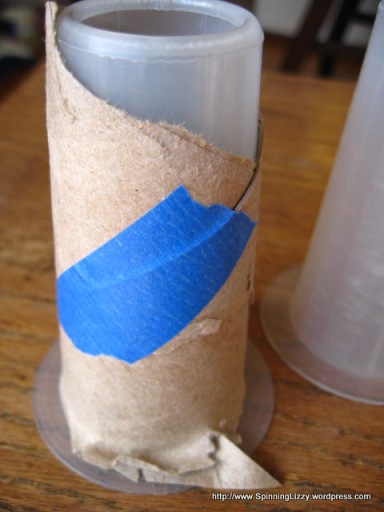Paper Cones On Cone Winders
Update to the previous post:
I was asked about putting paper cones over the removeable plastic cones. It’s possible with the toilet paper tubes, but it takes three tubes to make two cones.
I don’t bother with making flanges, as I’ll use the ones on the plastic cone. Use a second unwrapped paper tube, and add it over the uncovered areas; you’ll be able to cut off enough from the second tube to patch up a second cone. Put some tape on the inside (sticky side out) to tape the papers together.
Take the tube off, and trim the excess from the top and bottom. I wrapped very tightly, so a firm tug was needed to remove the paper from the plastic cone. The finished paper cone must be used with the plastic one, as it is too large to fit the cone winder directly.
Yarn Winders And The Humble Toilet Paper Tube
Up until a week ago, I have been winding all yarn by hand with a nØstepinde.
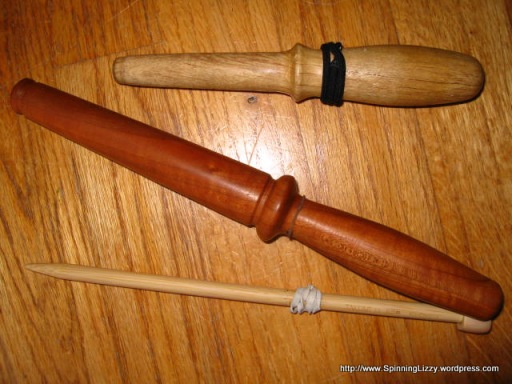
Notice the rubber bands around each of them? I use them to hold down the starting yarn end. They are capable of making very large, centre-pull balls.
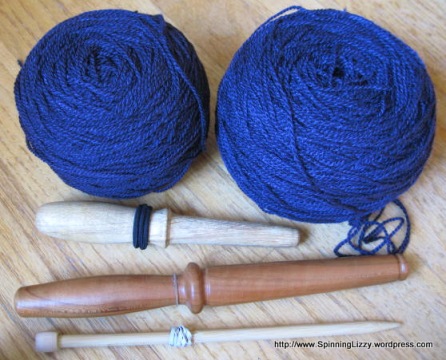
For three years, I’ve been holding out for a for a wooden ball winder, but since there is the tiny detail of not bringing in any income, I broke down and purchased a Royal ball winder.
It works, but I’m not overly impressed. I’m still faster on a nØstepinde, since I only need to wind a ball once, and because I don’t make mistakes that I have to spend time fixing. (I wind very loosely on a nØstepinde.) When using the ball winder, it’s best to re-wind a second ball out of the first, to make a looser ball that releases some of the stretching tension on the yarn. In addition, I can wind a larger ball on the nØstepinde, whereas the Royal — well, it can be a royal pain (although not impossible) for some skeins of yarn larger than four ounces. Where it really shines is when using sport or heavier weights; the nØstepinde is a gem for fingering and lace weights. (I was able to wind lighter weights on the Royal, but only by winding slowly and carefully.)
I’m used to the speed with which I can wind bobbins on my bobbin winders; with the Royal, I have to wind carefully and cannot crank the handle too fast (my normal speed), or else the gears start to slip. I think that winding too fast may cause the gears to eventually strip themselves. And, I have to pay attention to tensioning the yarn whilst winding, else it tends to run off course and wrap itself around the spinning mechanism. On the other hand, this ball winder creates a nicer looking cake of yarn than I usually do with a nØstepinde, and it puts less strain on my hands if I have a lot of yarn to wind.
Recently, someone on Ravelry reviewed the Royal cone winder, the first I had heard of the device. It was intriguing enough for me to purchase one second-hand.
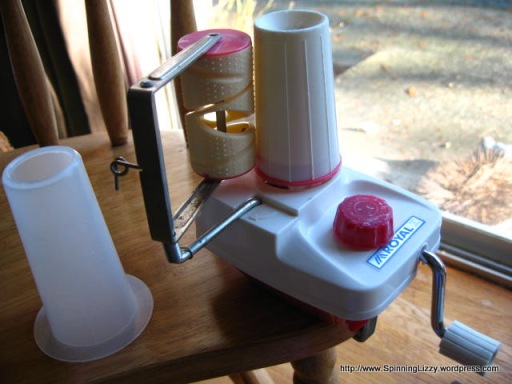
Until I received it and experimented with it, I had no idea that yarn cones unwound differently than balls do! Don’t laugh, but it was not until I wound and re-wound a cone of yarn that I learned that a cone of yarn remains stationary whilst unwinding from the top! (This, even after the kind Raveler tried to describe it to me.) I had been slinging the yarn cones on either a vertical or horizontal dowel, and was constantly dealing with unwinding yarn that wrapped and choked around the dowel. Here are some pictures showing how a cone of yarn unwinds:
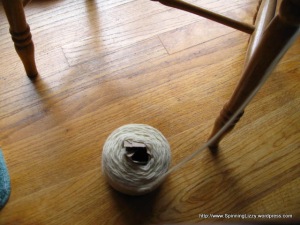



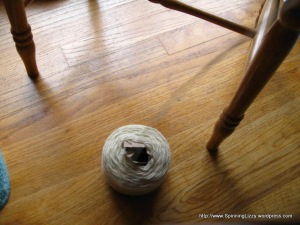

A Royal cone winder comes with two plastic cone sleeves. Extra sleeves may be purchased; but after including tax and shipping charges, I decided I could use the money elsewhere, and I set out to find a cheaper alternative.

Yes, it’s the paper tube that bath tissue is wound on. If you slip the paper tube directly onto the cone winder, it is too loose. But, if you carefully open up the tube along its diagonals, you can re-wrap the tube, pulling the paper tight about the winder (and making the required cone shape).

Wind the paper around the cone of the winder (or around a plastic sleeve if you want to use them at the same time), until all the paper is wound on, then tape the paper down to itself. I put the paper to the cone, with extra below the bottom of the cone (for flanges), and wrap the paper tightly around the cone until the cone is covered.

When winding on, it helps to add a piece of tape to the inside, sticky side facing out, so the paper will stick to itself as it is being wound around the cone (it’s the bit of tape to the left in the picture below).
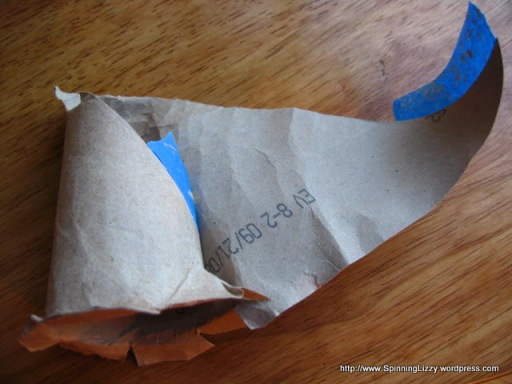
Cut the bottom flaps into flanges, rounding edges and corners. It’s not pretty, but it works!

To make a slightly taller cone, use the paper tube from a roll of paper towels instead. The paper tube technique works for the Royal ball winder as well:
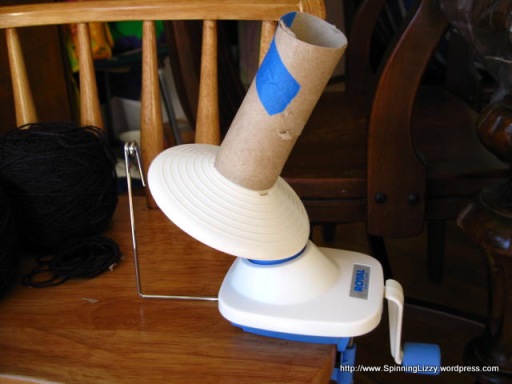
I found that I was able to wind an eight-ounce skein of Lion Brand Fisherman’s Wool into a cone without any problem. The Royal ball winder would not handle the same amount of yarn as gracefully. Here’s a tip I learned from Syne Mitchell: sandwich the starting end of yarn between the paper sleeve and the cone; this holds the yarn end out of the way, fits the sleeve onto the cone more snugly, and is faster than threading the yarn onto a slit in a tube or cone.

The cone sleeve is left inside the yarn, and the resulting cone of yarn is sturdy and very stable.

Another mammoth cone of yarn wound onto a plastic cone sleeve:

Time to experiment with the different yarn winders!

Here is the difference between a skein of yarn wound once (left) or twice (the second time so the yarn isn’t stretched) on a ball-winder:
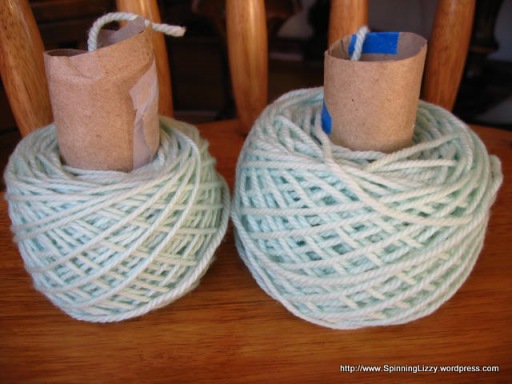
A cake of yarn wound on a ball-winder is not meant to be stored around an insert; removing it allows the yarn to loosen and relax:

I enjoy using a nØstepinde, and I feel less guilty about wasting time in front of the television if I do my winding then. It’s also a wonderful way to prolong my admiration of a beautiful hand-spun, and let me say that it’s not (rather, it doesn’t have to be) a slow way of winding yarn! Here’s a skein wound on a nØsty:
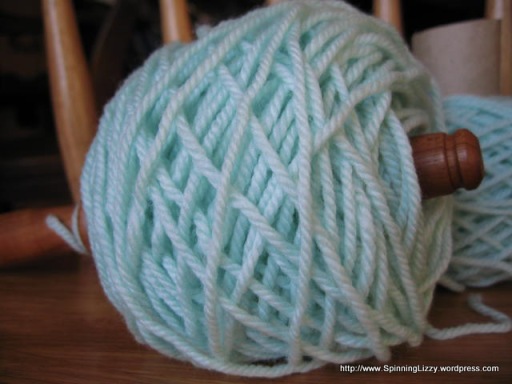
Below, a comparison: Top, cone-wound; Left, nØsty-wound; Right, ball-winder-wound:
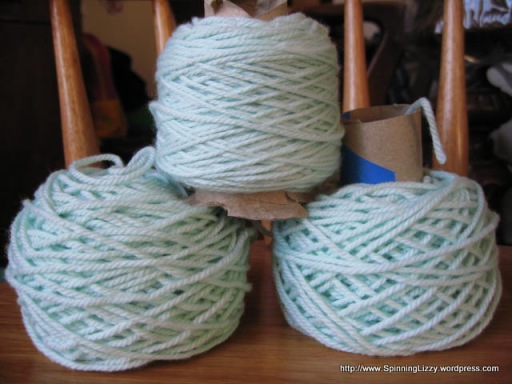
Notice how much smaller and tightly-wound the cone-wound yarn is!
Why get both the cone and ball winders? Yarn cones work very well for unwinding yarn when warping, or in situations (like machine knitting) where yarn feed needs to be smooth and even. Yarn unwound from balls, even pulling from the centre, rolls all over the floor, unwinding too unevenly for warping. Knitters will find centre-pull balls more convenient, and a properly-wound cake removes tension and stress from yarn for long-term storage. (Weavers store yarn wound on cones indefinitely; is there a good reason to relax that yarn before weaving with it?)
Syne Mitchell told me that she wasn’t satisfied with the perfomance of a certain expensive wooden ball-winder, and returned it to the dealer. I wonder if its performance had anything to do with the fact that these winders were made with knitters in mind, and so tend to perform better with thicker yarns? I would also wonder what weavers use for finer threads, but I’ll save that for another day when I can afford to.
